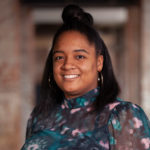 WSA Design Specialist Tianna St. James is a member of the National Organization of Minority Architects’ (NOMA) Columbus Chapter (NOMAColumbus). She serves on the Chapter Board as the Project Pipeline Chair and was the Director of NOMAColumbus’s 2023 Project Pipeline Design Summer Camp.
WSA Design Specialist Tianna St. James is a member of the National Organization of Minority Architects’ (NOMA) Columbus Chapter (NOMAColumbus). She serves on the Chapter Board as the Project Pipeline Chair and was the Director of NOMAColumbus’s 2023 Project Pipeline Design Summer Camp.
NOMAColumbus’s 2023 Project Pipeline Summer Camp was the first camp the Columbus chapter has held. For 3 days in the summer, Columbus-area students from different backgrounds joined NOMAColumbus members at The Ohio State University’s Knowlton School of Architecture for hands-on exposure to the architecture and design world.
Project Pipeline is an initiative created by NOMA (National Organization of Minority Architects) that champions and highlights the importance of representation, diversity, mentorship, and community in architecture. I believe the inspiration behind it was developed because NOMA understands how important it is to provide representation, exposure, and mentorship from all stages of the design pathway towards licensure and beyond. Many minorities, such as myself, work in an industry where most people don’t look like us, face the same challenges, or come from the same experiences or cultural backgrounds.
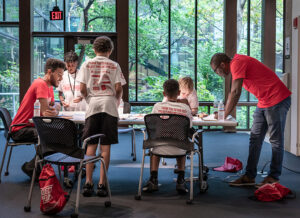 Therefore, as architects and adjacent design professionals, we must continue to celebrate & empower the creative diverse minds that we have in our local communities through design. One major step towards accomplishing this is by serving a population of diverse students and design professionals, all of whom are underrepresented in architecture and design. Through our Project Pipeline programs, such as the Design Summer Camp, we will continue to help foster the next generation of design professionals, change makers, civic leaders, and respected voices. We have, and always will, continue to advocate for inclusiveness, diversity, fellowship, equity, and excellence in design.
Therefore, as architects and adjacent design professionals, we must continue to celebrate & empower the creative diverse minds that we have in our local communities through design. One major step towards accomplishing this is by serving a population of diverse students and design professionals, all of whom are underrepresented in architecture and design. Through our Project Pipeline programs, such as the Design Summer Camp, we will continue to help foster the next generation of design professionals, change makers, civic leaders, and respected voices. We have, and always will, continue to advocate for inclusiveness, diversity, fellowship, equity, and excellence in design.
The goal of the camp was for students to get the chance to be introduced to architecture and adjacent design professions, while exploring their own creative exploration for design. Design Summer Camp allows them to see the value in their voice, their experiences, and how to take their perspectives and apply it through design thinking. Going in, I hoped they would learn and understand how architecture is a fundamental part of the human experience and most importantly their experience.
THE AHA MOMENTS
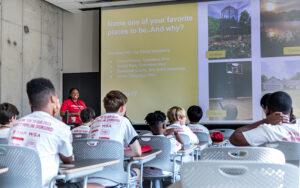 A memorable part of this year’s Design Summer Camp was witnessing the ‘aha’ moments for many students as they connected the beauty in their design ideas to their community and its functional needs of the built environment. They began to understand that we, as architects and designers, should not just be designing to design – every design choice impacts how people navigate throughout spaces, how we see, touch, smell and hear within those spaces. They held creative dialogues with their team members and our volunteers on how they could make their spaces inclusive to all. Watching as they prioritize the community members’ needs and how they began to learn the importance of diversity and inclusion was rewarding to witness. Plus, they created some amazing projects, models, and design ideas – that was the cherry on top!
A memorable part of this year’s Design Summer Camp was witnessing the ‘aha’ moments for many students as they connected the beauty in their design ideas to their community and its functional needs of the built environment. They began to understand that we, as architects and designers, should not just be designing to design – every design choice impacts how people navigate throughout spaces, how we see, touch, smell and hear within those spaces. They held creative dialogues with their team members and our volunteers on how they could make their spaces inclusive to all. Watching as they prioritize the community members’ needs and how they began to learn the importance of diversity and inclusion was rewarding to witness. Plus, they created some amazing projects, models, and design ideas – that was the cherry on top!
Along with all the great staff and volunteers at the camp, I was joined by a fellow WSA team member, Amy Mattingly. Amy worked closely with students in their activities and got a chance to see first-hand the ideas starting to click, the wheels turning, and the lightbulbs switching on.
“The students seemed to connect best with hands-on experiences. While presentations are helpful to introduce ideas, the best way to learn is to do,” Amy said. “With Legos, model building, field trips, sketching exercises, programming – all three days were packed with activities!”
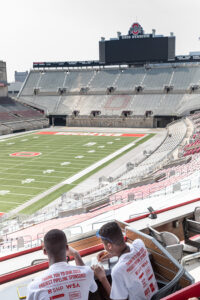 This camp was heavily influenced by mine and many other minorities’ educational experiences. It was extremely important to my team and I that the students were exposed to diverse architects, engineers, and adjacent design professionals from various ethnicities and backgrounds.
This camp was heavily influenced by mine and many other minorities’ educational experiences. It was extremely important to my team and I that the students were exposed to diverse architects, engineers, and adjacent design professionals from various ethnicities and backgrounds.
“So much of the formal process of teaching design was new to me,” Amy said. “It was fascinating to see a structured approach to design and problem solving, albeit one appropriate for the age level of our middle and high-school students.”
As a kid, college student, and even emerging professional in architecture, too often minorities in design fields never get the chance to see someone that looks like them thriving in these types of professions. We want to remind them, we are out here, you are worthy, and you are more than capable in pursuing architecture while being supported, mentored and valued.
“The camp volunteers ranged from architects, engineers, interior designers and community members with no design background– who just wanted to help students explore new fields and envision new futures,” Amy added. “We had a diverse group of volunteers in terms of race, age, gender and background – it seemed everyone had multiple life and professional experiences that contributed to the overall success of the camp.”
PIPELINE CONNECTIONS
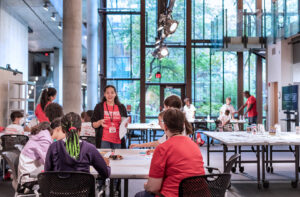 It was exciting and inspiring to watch how the students connected with our staff throughout the various stages of camp. There is power in educational experiences of course, but it is also just as powerful for our youth to simply be kids in a new environment – one that brings another sense of joy. Learning in these types of camps is very important, but also being able to provide a safe space for students to be themselves, to live and laugh in joy—especially in a world that doesn’t always respect or value them All of the students come from different backgrounds, races, ethnicities and experiences and they each deserve to feel heard, to explore their ideas, and to simply be a kid.
It was exciting and inspiring to watch how the students connected with our staff throughout the various stages of camp. There is power in educational experiences of course, but it is also just as powerful for our youth to simply be kids in a new environment – one that brings another sense of joy. Learning in these types of camps is very important, but also being able to provide a safe space for students to be themselves, to live and laugh in joy—especially in a world that doesn’t always respect or value them All of the students come from different backgrounds, races, ethnicities and experiences and they each deserve to feel heard, to explore their ideas, and to simply be a kid.
The camp got students out of their shells. It exposed them to something new in a fun and engaging way. The team behind it made our world somewhere they could see themselves. The backgrounds of the Project Pipeline committee team and NOMAColumbus members played a huge role in the camp holistically because it allowed us to tap into the various skillsets and experiences that we each brought to the table. It allowed people to champion key parts of the camp, presentations, programming, and overall activities. These diverse perspectives, I truly believe were a key part in the success of the camp.
INSPIRING THE NEXT GENERATION OF ARCHITECTS, DESIGNERS, AND MORE
“On the last day, students pinned up all their work and laid out their models. Family, sponsors, and guests then attended their exhibition – and the students answered questions about their work and presented their models. Some students really bloomed when talking about their projects and how their design responded to community context. Most students – even those who weren’t excited to speak in front of family and strangers – came to life when they started talking about their work and their process.”
This story from Amy really sums up what the camp was about. Through architecture and design, we not only introduced students to the possibility of a future in the professional field, but showed them that they have the tools, the creativity, and the confidence to excel in whatever they choose.
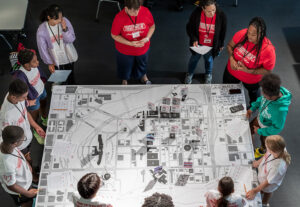 The team received so much amazing and positive feedback from parents, students, guests, and leading design professionals. Many parents said their children felt valued and heard. They also shared that they had a lot of fun and wished the camp was longer so they could continue working on their projects.
The team received so much amazing and positive feedback from parents, students, guests, and leading design professionals. Many parents said their children felt valued and heard. They also shared that they had a lot of fun and wished the camp was longer so they could continue working on their projects.
“(A parent) emailed us and let us know that normally her daughter felt extra shy at camps and often didn’t enjoy them,” Amy said. “But her daughter was excited to return to camp each day – the staff and content was really connecting with her. It was a helpful reminder that not all students will appear the same ‘from the outside.’ Just because they are quiet and not engaging verbally doesn’t mean that they aren’t absorbing everything and connecting to a new passion.”
BEYOND THE CAMP
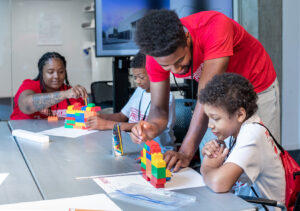 Project Pipeline understands the importance of being an advocate towards building up and diversifying the pipeline in architecture and design starting with our youth. I want everyone to know there is a nationally known platform that they can connect and engage with you on a professional level, but also on a human experience level. Understanding that if students from underrepresented communities are interested – even the slightest bit – in pursuing architecture, engineering, interior design, or any adjacent design profession, WE will be a resource within an organization that is here for them.
Project Pipeline understands the importance of being an advocate towards building up and diversifying the pipeline in architecture and design starting with our youth. I want everyone to know there is a nationally known platform that they can connect and engage with you on a professional level, but also on a human experience level. Understanding that if students from underrepresented communities are interested – even the slightest bit – in pursuing architecture, engineering, interior design, or any adjacent design profession, WE will be a resource within an organization that is here for them.
“Kids should try lots of different things, even if they don’t think a particular field could be their career,” Amy said. “The more exposure they have to lots of different options, the better prepared they’ll be to find meaningful work in whatever field they choose. And seeing faces like their own – leading, teaching, succeeding – can provide proof that they can also be successful.”
We hope to continue to grow minorities in leadership positions in our field, growth in licensure and growth in students being prepared to pursue and tackle the challenges they may face on this pathway. Their potential is limitless, and NOMAClombus’s Project Pipeline will continue to champion diversity, equity, and inclusion.
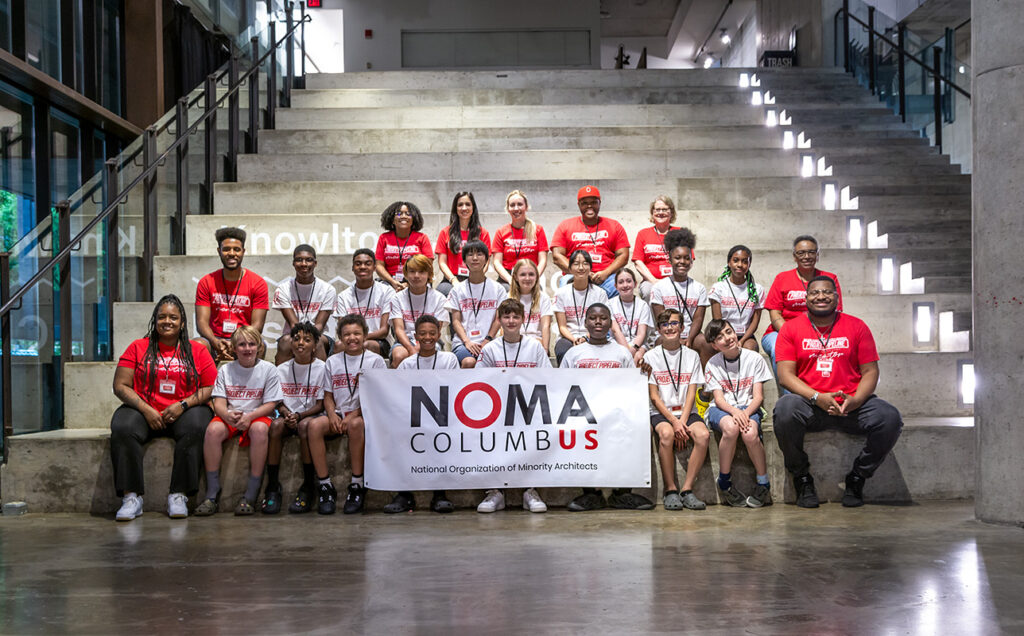
Learn more about NOMA’s Project Pipeline initiative
Connect with NOMAColumbus
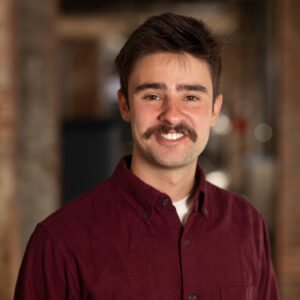 A new duck has joined the WSA Quack Squad. Ben Moody joins WSA as a Design Specialist. He comes to Columbus from Gallipolis, Ohio, and is a recent graduate of The Ohio State University’s Knowlton School of Architecture.
A new duck has joined the WSA Quack Squad. Ben Moody joins WSA as a Design Specialist. He comes to Columbus from Gallipolis, Ohio, and is a recent graduate of The Ohio State University’s Knowlton School of Architecture. WSA Design Specialist Tianna St. James is a member of the
WSA Design Specialist Tianna St. James is a member of the Therefore, as architects and adjacent design professionals, we must continue to celebrate & empower the creative diverse minds that we have in our local communities through design. One major step towards accomplishing this is by serving a population of diverse students and design professionals, all of whom are underrepresented in architecture and design. Through our Project Pipeline programs, such as the Design Summer Camp, we will continue to help foster the next generation of design professionals, change makers, civic leaders, and respected voices. We have, and always will, continue to advocate for inclusiveness, diversity, fellowship, equity, and excellence in design.
Therefore, as architects and adjacent design professionals, we must continue to celebrate & empower the creative diverse minds that we have in our local communities through design. One major step towards accomplishing this is by serving a population of diverse students and design professionals, all of whom are underrepresented in architecture and design. Through our Project Pipeline programs, such as the Design Summer Camp, we will continue to help foster the next generation of design professionals, change makers, civic leaders, and respected voices. We have, and always will, continue to advocate for inclusiveness, diversity, fellowship, equity, and excellence in design. A memorable part of this year’s Design Summer Camp was witnessing the ‘aha’ moments for many students as they connected the beauty in their design ideas to their community and its functional needs of the built environment. They began to understand that we, as architects and designers, should not just be designing to design – every design choice impacts how people navigate throughout spaces, how we see, touch, smell and hear within those spaces. They held creative dialogues with their team members and our volunteers on how they could make their spaces inclusive to all. Watching as they prioritize the community members’ needs and how they began to learn the importance of diversity and inclusion was rewarding to witness. Plus, they created some amazing projects, models, and design ideas – that was the cherry on top!
A memorable part of this year’s Design Summer Camp was witnessing the ‘aha’ moments for many students as they connected the beauty in their design ideas to their community and its functional needs of the built environment. They began to understand that we, as architects and designers, should not just be designing to design – every design choice impacts how people navigate throughout spaces, how we see, touch, smell and hear within those spaces. They held creative dialogues with their team members and our volunteers on how they could make their spaces inclusive to all. Watching as they prioritize the community members’ needs and how they began to learn the importance of diversity and inclusion was rewarding to witness. Plus, they created some amazing projects, models, and design ideas – that was the cherry on top! This camp was heavily influenced by mine and many other minorities’ educational experiences. It was extremely important to my team and I that the students were exposed to diverse architects, engineers, and adjacent design professionals from various ethnicities and backgrounds.
This camp was heavily influenced by mine and many other minorities’ educational experiences. It was extremely important to my team and I that the students were exposed to diverse architects, engineers, and adjacent design professionals from various ethnicities and backgrounds. It was exciting and inspiring to watch how the students connected with our staff throughout the various stages of camp. There is power in educational experiences of course, but it is also just as powerful for our youth to simply be kids in a new environment – one that brings another sense of joy. Learning in these types of camps is very important, but also being able to provide a safe space for students to be themselves, to live and laugh in joy—especially in a world that doesn’t always respect or value them All of the students come from different backgrounds, races, ethnicities and experiences and they each deserve to feel heard, to explore their ideas, and to simply be a kid.
It was exciting and inspiring to watch how the students connected with our staff throughout the various stages of camp. There is power in educational experiences of course, but it is also just as powerful for our youth to simply be kids in a new environment – one that brings another sense of joy. Learning in these types of camps is very important, but also being able to provide a safe space for students to be themselves, to live and laugh in joy—especially in a world that doesn’t always respect or value them All of the students come from different backgrounds, races, ethnicities and experiences and they each deserve to feel heard, to explore their ideas, and to simply be a kid. The team received so much amazing and positive feedback from parents, students, guests, and leading design professionals. Many parents said their children felt valued and heard. They also shared that they had a lot of fun and wished the camp was longer so they could continue working on their projects.
The team received so much amazing and positive feedback from parents, students, guests, and leading design professionals. Many parents said their children felt valued and heard. They also shared that they had a lot of fun and wished the camp was longer so they could continue working on their projects. Project Pipeline understands the importance of being an advocate towards building up and diversifying the pipeline in architecture and design starting with our youth. I want everyone to know there is a nationally known platform that they can connect and engage with you on a professional level, but also on a human experience level. Understanding that if students from underrepresented communities are interested – even the slightest bit – in pursuing architecture, engineering, interior design, or any adjacent design profession, WE will be a resource within an organization that is here for them.
Project Pipeline understands the importance of being an advocate towards building up and diversifying the pipeline in architecture and design starting with our youth. I want everyone to know there is a nationally known platform that they can connect and engage with you on a professional level, but also on a human experience level. Understanding that if students from underrepresented communities are interested – even the slightest bit – in pursuing architecture, engineering, interior design, or any adjacent design profession, WE will be a resource within an organization that is here for them.